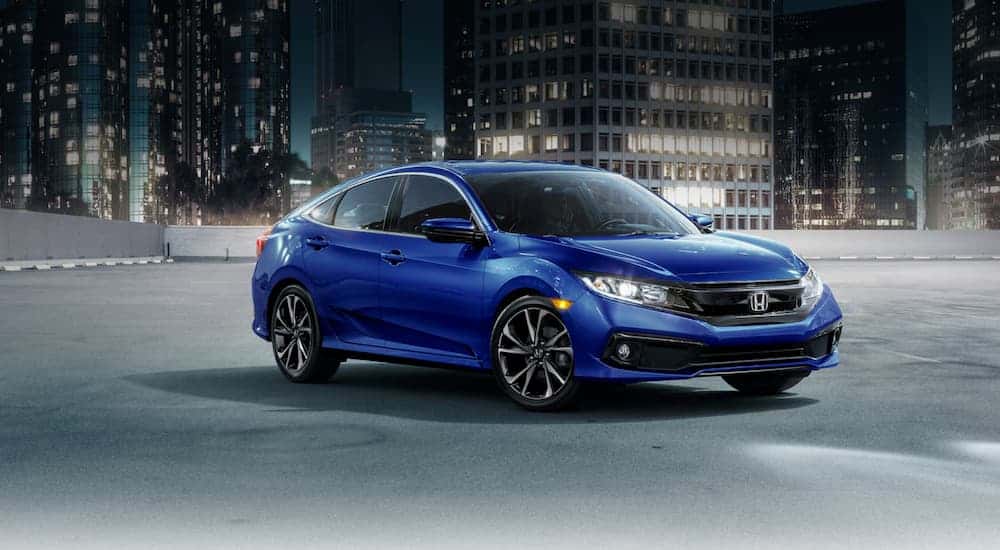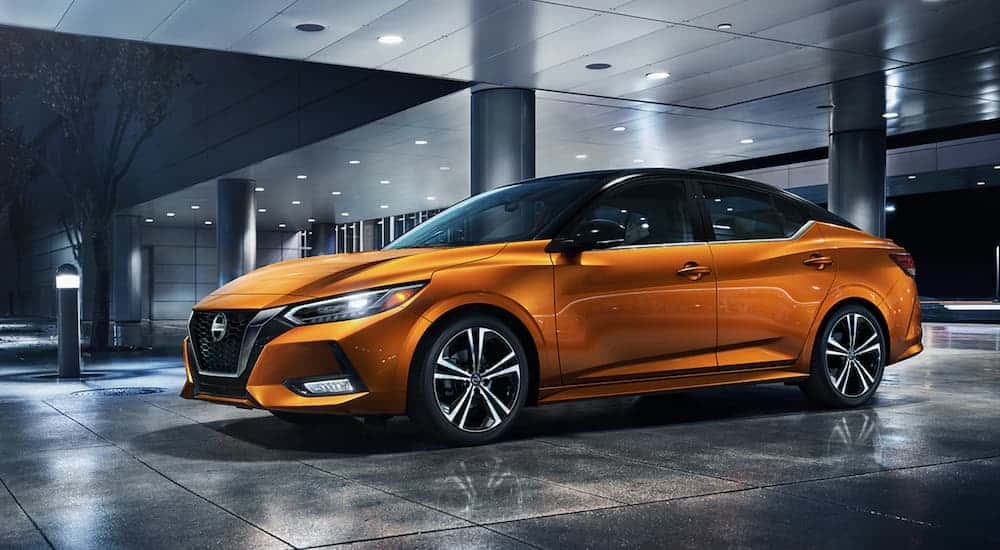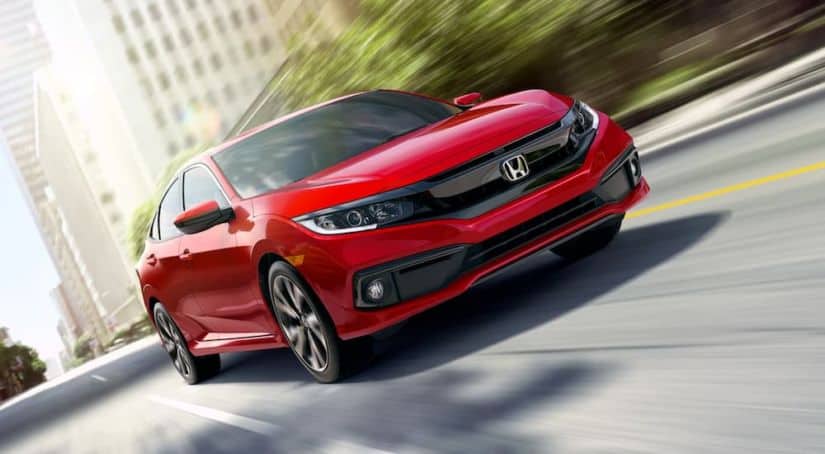Compact sedans make a great car for commuters, providing a dependable ride that can get you to work safely and efficiently, with great fuel economy. They also are perfect for young drivers who want a good car that won’t cost an arm and a leg. Compact sedans are also ideal for an older couple whose kids have grown up and left the house and who are looking to downsize without downgrading. Whoever, you may be, two options that you will probably want to compare are the 2021 Honda Civic vs 2021 Nissan Sentra, two excellent compact sedans on the market today. Let’s take a look at how these two compare on some critical features for all drivers, whether you’re buying your compact sedan for a commute to work, your first car, or a car to save money for empty nesters.
Pricing and Trims
Both the 2021 Honda Civic and the 2021 Nissan Sentra offer multiple trims at affordable prices. Looking solely at pricing, the Sentra would appear to have the edge over the Civic. The Sentra has a base MSRP of $19,460, while the Civic has a base MSRP of $21,250. Moreover, the top trim Sentra SR starts at $21,800, which is fully $6,500 less than the top trim Civic Touring. However, the pricing can be a bit misleading.
Honda offers five different trim levels of the Civic while Nissan only offers three trims on the Sentra. As a result, you get more options when you choose a Civic, even if the price is slightly higher. The base model of the Civic is the LX for an MSRP of $21,250. The Civic Sport starts at $23,050 and adds features like a leather-wrapped steering wheel and shift knob, as well as Apple CarPlay and Android Auto integration on the Honda infotainment system. The Civic EX comes with a more powerful engine, as well a one-touch power moonroof and an 8-way power driver’s seat, for an MSRP of $24,400. The EX-L starts at $25,600 and adds leather seats, an automatic dimming rearview mirror, and Honda’s HomeLink Remote System. The top trim is the Civic Touring, which adds Honda Satellite-Linked Navigation System, LED headlights with automatic on/off, a 450-watt premium audio system, and 18-inch alloy wheels.
In comparison, Nissan limits your choice with only three trims. The base trim is the Sentra S with an MSRP of $19,460, followed by the SV with a starting price of $20,520, larger wheels, and intelligent cruise control. The top trim, the Sentra SR, has an MSRP of $21,800 and adds LED daytime running lights and 18-inch wheels. However, if you want any luxury features like leather seats or a premium audio system, you will have to spring for optional packages on one of the two higher trims, where such features come as standard on many trims of the Honda Civic.

Engines and Performance
The 2021 Honda Civic offers two choices of engine. The LX and Sport trims are equipped with a 2.0-liter I-4 engine paired with an M-CVT continuously variable transmission. The Sport model adds paddle shifters for greater control and ease of shifting. The engine itself has a 16-valve Double Overhead Cam (DOHC) configuration with Honda’s i-VTEC system as well as multi-point fuel injection. As a result, the engine can produce 158 horsepower and 138 pounds to feet of torque, giving the Civic solid acceleration.
The second engine is a 1.5-liter turbocharged I-4 and comes standard on the EX, EX-L, and Touring trims. This is paired with an LL-CVT, a more advanced version of Honda’s CVT transmission, and the Touring model features paddle shifters just like the Civic Sport. The upgraded engine is also a 16-valve DOHC design but utilizes a turbocharger and direct fuel injection to improve performance and fuel efficiency. As a result, the Civic with the turbo I-4 can produce 174 horsepower and generate 162 pounds to feet of torque while getting better fuel economy.
The 2021 Nissan Sentra has only one standard engine, a 2.0-liter I-4 gas engine. It also has a 16-valve DOHC configuration with direct fuel injection. The transmission is Nissan’s Xtronic CVT, but there is no option for paddle shifters. The engine itself produces 149 horsepower and 146 pounds to feet of torque, which is comparable to the numbers on the standard engine of the Civic but pales in comparison to the turbo I-4 on the Civic EX, EX-L, and Touring. As a result, you should expect those three higher trims to provide better overall acceleration and speed than any 2021 Sentra.
Fuel economy numbers also yield the same result. The 2021 Civic with the 2.0-liter I-4 will provide you with 30 miles per gallon in city driving and 38 miles per gallon on the highway. This is similar to the 2021 Sentra, which will get an estimated 29 miles per gallon in the city and 39 miles per gallon on the highway. However, these figures are blown off the road by the Civic with the 1.5-liter turbo, which gets an estimated 32 miles per gallon in city driving and 42 miles per gallon on the highway.
You will also find that the 2021 Civic will give you a better ride than the 2021 Sentra. In fact, the 2021 Sentra still comes standard with rear drum brakes, while the Civic has had four-wheel disc brakes for years. Also, most Civic models are equipped with larger wheels than comparable Sentra models, giving you better handling. While the Civic LX has 16-inch wheels like the Sentra S and SV, the Civic EX and EX-L come with 17-inch alloy wheels, and the Civic Sport and Touring have 18-inch alloy wheels. The only Sentra model with standard larger wheels is the top Sentra SR. For these reasons, the 2021 Honda Civic easily outperforms the 2021 Nissan Sentra on the road.
Standard Safety Features
Both the 2021 Honda Civic and 2021 Nissan Sentra have been named Top Safety Picks by the Insurance Institute for Highway Safety. That is because both Honda and Nissan have made safety a focus on their compact sedans, with Honda offering the Honda Sensing Safety & Driver-Assistive Technologies standard on all trims of the 2021 Civic, while Nissan includes its Safety Shield 360 as standard on the 2021 Sentra. Both of these safety suites do an amazing job at improving driver awareness and preventing accidents. However, Honda Sensing has a few extra features that give the Civic an edge. For instance, Nissan does not include Intelligent Cruise Control on the base model Sentra S, while Honda does include its Adaptive Cruise Control with Low-Speed Follow on the base model Civic LX.

Interior and Exterior Capacities
One issue many drivers have with compact sedans is roominess. While the front seats may be comfortable enough, many compact sedans have a backseat that seems to be little more than an afterthought. This is not the case with at least one of these two sedans. The 2021 Honda Civic offers 97.8 cubic feet of interior space, which shrinks slightly to 95 cubic feet on the three models with the moonroof. This is an edge over the 2021 Nissan Sentra, which has 96 cubic feet of interior space on most models but only 94.1 cubic feet on models with a moonroof. This is the result of more efficient use of space by Honda since the Nissan Sentra actually has larger exterior dimensions than the Civic.
This difference in interior space between these two models is most pronounced in headroom and legroom, two of the most critical factors when you are looking to fit five passengers into your car. The Civic has 39.3 inches of headroom in the front row compared to only 38.9 inches in the Sentra. The rear seat headroom also favors the Civic 37.1 inches to only 36.7 inches in the Sentra. But if headroom favors the Civic, legroom puts it far in the lead. The Sentra only has 34.7 inches of legroom in the back, which could cause serious leg cramping for backseat passengers in long drives in the Sentra. The Civic doesn’t have this problem with a very generous 37.4 inches of legroom in the rear row of seats.
Finally, the 2021 Civic also has more trunk space than the 2021 Sentra. The Civic’s trunk has a full 15.1 cubic feet of space for cargo and belongings, while the Sentra only offers 14.3 cubic feet in its trunk. In short, the Civic may be a compact car, but it competes with many midsize options when it comes to interior space.
Showdown Winner
While both the 2021 Honda Civic and 2021 Nissan Sentra provide excellent value for the money in a compact sedan, it is clear that the Civic is a better overall buy. Aside from providing more choices through a greater number of trims and two engine options, the Civic also has more standard safety features, superior performance and handling, and more interior space than the Sentra. There is a reason why the Civic has been the best-selling compact sedan in America for years.



